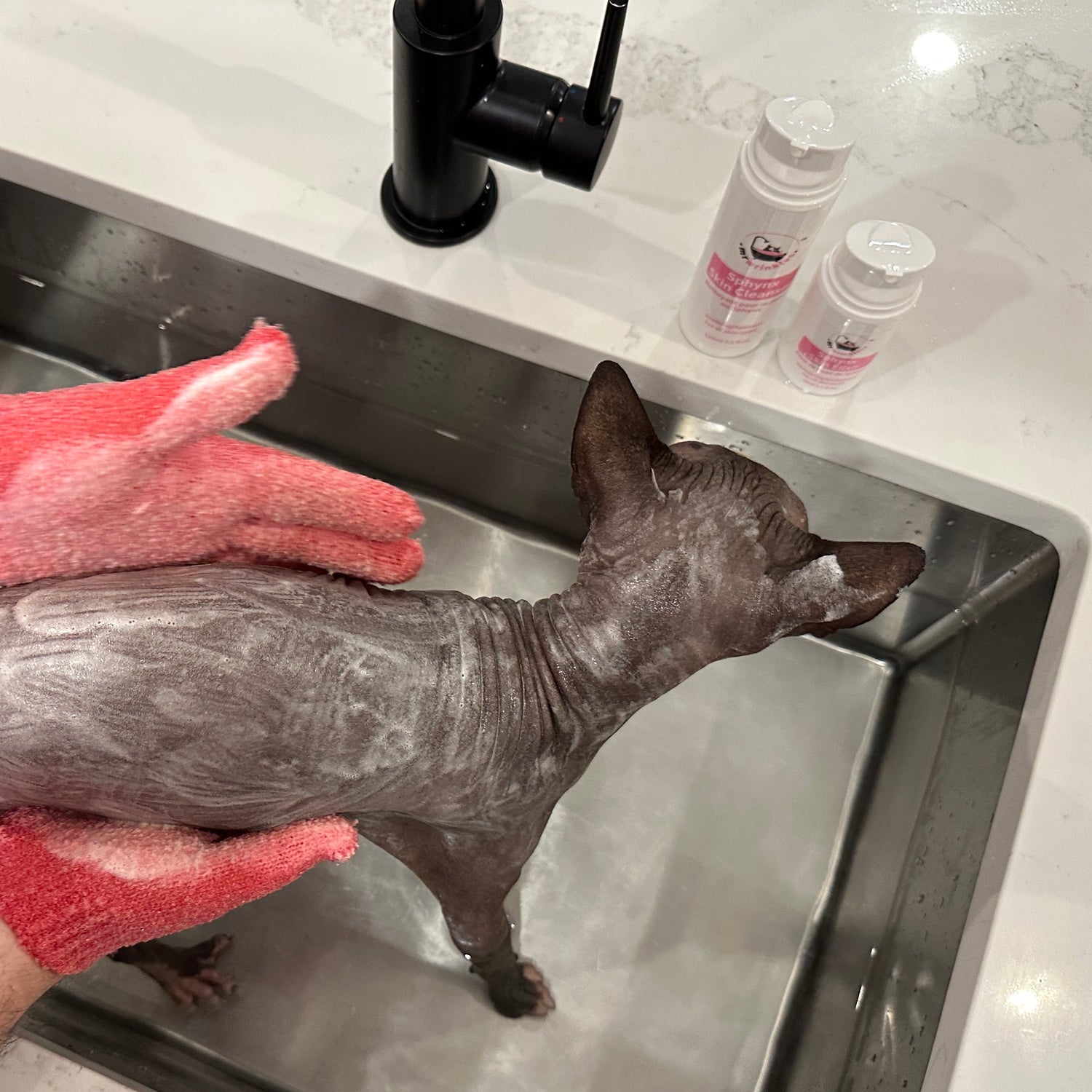
Your Sphynx Kitten's First Bath!
Share
Your Sphynx Kitten’s First Bath: When to Start, What to Use, and How to Protect Their Delicate Skin
Co-authored with Nicole Warner, Sphynx of Sarnia
Welcoming a Sphynx kitten into your life is a little like adopting a tiny alien roommate—adorable, affectionate, and a bit mysterious when it comes to their skincare needs. One of the first big questions new parents ask is: When should I give my kitten a bath? And more importantly, how?
Bathing too soon (or with the wrong products) can do more harm than good. But with the right timing and a gentle approach, that first bath can be a bonding moment that sets your kitten up for a lifetime of healthy skin.
Why Is Kitten Skin So Sensitive?
Sphynx kittens aren’t just smaller—they’re still developing their skin barrier and microbiome. That means they’re more prone to irritation from water, friction, or the wrong products.
Here’s what makes kitten skin extra delicate:
- Thinner skin layers = less protection
- Immature microbiome = more prone to imbalance
- Oil fluctuations = some kittens get greasy fast, others stay dry
The goal in the early months isn’t to scrub them spotless—it’s to support their natural skin development.
🐾 Nicole Warner, Sphynx of Sarnia:
“As a Sphynx breeder, I’ve learned that when it comes to caring for kitten skin, less is truly more. Sphynx kittens are born with incredibly delicate skin, and introducing them to a bath routine should always be done gently and gradually.”
When Is It Safe to Bathe a Sphynx Kitten?
We typically recommend waiting until your kitten is 12 to 16 weeks old for their first proper bath. By then, they’ve weaned, settled into their environment, and their skin has matured enough for light cleansing.
Before then, spot-cleaning with a warm, damp cloth is more than enough.
🐾 Geoff Teoli, Co-founder of Mr. Wrinkles:
“When we first adopted Mr. Wrinkles, our vet gave us some advice that really stuck with us: give your new cat—kitten or adult—at least a week to settle into their new environment before introducing the stress of a bath. Even if their skin looks a little oily or dirty, it’s better to focus on bonding and letting them feel safe before adding anything unfamiliar. That little bit of patience goes a long way in building trust (and making future baths much easier).”
Signs they might be ready for a bath:
- They have settled into their new home
- Dirt collecting in folds
- Light flaking or oil buildup
- Sticky feel on skin when petting
But remember: if they don’t need it—don’t force it.
Kitten's First Bath—Step-by-Step
When you’re ready to take the plunge (pun intended), here’s how to keep things kitten-safe and stress-free:
- Warm the room first—it makes a big difference for tiny bodies.
- Use lukewarm water—test it with your wrist, not your hand.
- Choose a gentle cleanser, ideally pH-balanced (6.0) and free of synthetics. Our Soothing Sphynx Skin Cleanser is a great starter option.
- Massage gently, avoiding the eyes and inside the ears.
- Rinse or wipe clean using a clean, damp cloth.
- Pat dry with a soft towel—don’t rub!
- Cuddle time. Wrap them up and let them rest somewhere warm.
💡 Heads-up!
It’s not uncommon for kittens to develop a mild rash or pink flush after a bath, especially from warm water. Don’t panic—this usually fades within a few hours. It’s just their skin adjusting to new sensations.
🐾 Nicole Warner, Sphynx of Sarnia:
“I recommend using the sink instead of a bathtub for their early baths—it’s a smaller, cozier space for the kitten, and it saves your back, too. At this stage, it’s important to skip anything abrasive—no exfoliating mitts or scrubbers. Instead, just warm water, a soft microfiber cloth, or even just your hands are all you need.”
Creating a Gentle Routine That Grows With Them
- Start slow—baths every 3–4 weeks at most
- Use cat-safe products only (pH 6.0, natural, no essential oils)
- Watch their skin—adjust frequency as they grow and settle
- Support the microbiome by keeping things simple and consistent
🐾 Nicole Warner, Sphynx of Sarnia:
“We’ve had great success using Mr Wrinkles Petcare Skin Cleanser. It’s gentle enough for sensitive skin and effective enough that we rarely need anything else. With kittens, we keep it simple: cleanser, water, and a loving touch. That’s all it takes to keep their skin clean without overwhelming them.”
Closing Thoughts
That first bath is just the beginning. With a little patience (and the right products), you’ll set your kitten up for healthy, balanced skin that looks and feels its best.
Want more help? Browse our Ultimate Guide to Sphynx Skin Care or drop us a note—we’re here to support you and your skinfant every step of the way. You can reach us as info@mrwrinkles.com
About the Co-Author
Nicole Warner is the founder of Sphynx of Sarnia, a well-respected cattery located in Ontario, Canada. Known for raising exceptionally socialized and healthy kittens, Nicole works closely with adopters to help them build confident, well-adjusted companions—with skincare support that starts on day one.
Still have questions?
We’ve got you covered. Here are some of the most common concerns from new Sphynx parents—answered with expert care.👇
Need personalized help? Contact us anytime—we’re always happy to chat!
Frequently Asked Questions
1. What is the best shampoo for Sphynx kittens?
Most shampoos—even those marketed as gentle—can be too harsh for a Sphynx kitten’s sensitive skin. That’s why we recommend avoiding traditional shampoos altogether. Instead, use a pH-balanced, natural cleanser like our Soothing Skin Cleanser, which is specifically formulated for hairless pets. It’s gentle enough for first-time baths and helps maintain your kitten’s delicate skin barrier.
2. When can I give my Sphynx kitten their first bath?
It’s usually safe to bathe a Sphynx kitten between 12 and 16 weeks of age, once they’ve adjusted to their new home and their skin has matured. Before that, stick to spot-cleaning with a warm, damp cloth.
3. My kitten got a rash after their bath—is that normal?
A mild pink flush or rash after bathing is common in young Sphynx cats. Their skin is highly sensitive and can react to water temperature or friction. If the redness is light and fades within a few hours, there’s no cause for concern. If irritation lasts longer, check the ingredients in your cleanser or consult your vet.
4. How often should I bathe my Sphynx kitten?
Kittens don’t need frequent bathing. In fact, over-washing can disrupt their natural oil balance. A gentle bath every 3–4 weeks is usually enough, unless your vet or breeder advises otherwise.

